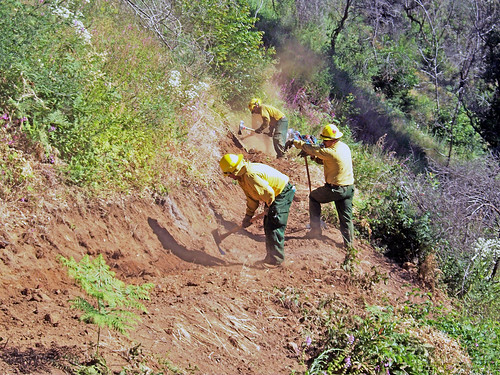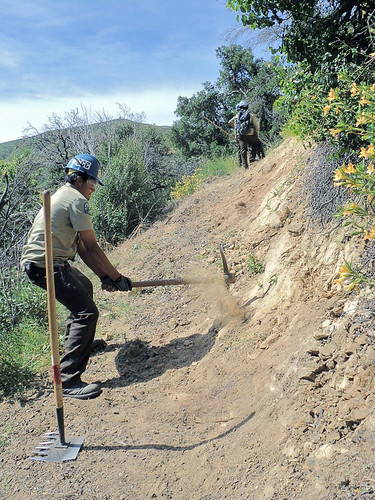
Recovery Act funding spurs a renaissance in backcountry trail maintenance.
This year, visitors to the Los Padres National Forest, near Goleta, Calif., are seeing widespread wilderness trail improvements thanks to Recovery Act funds. Nearly $2.3 million was allocated to the forest for wilderness trail rehabilitation and maintenance which was divided among its five ranger districts.
Of the 1.75 million acres that comprise the forest, 48 percent is designated wilderness. Many popular trails in several wilderness areas have been severely degraded and damaged by large landscape fires over the past several years. As a result, some sections of trails have been difficult for travelers to traverse or have been closed to the public.
With Recovery Act funding, dozens of local jobs were created and 191 miles of wilderness trails were rehabilitated in the wilderness areas. Seasonal wilderness rangers and a packer-support person were hired, as well as California Conservation Corps (CCC) members located in San Luis Obispo and Santa Maria.

"The funds allowed us to open up key wilderness trails that hadn't been maintained to Forest Service standards in over a decade," according to Santa Lucia District Recreation Officer Ken Kunert. "The intent of the Recovery Act was to put people back to work and improve infrastructure on public lands, and we accomplished both."
California Conservation Corps member Kenny Martinez said his experience with the Forest Service was an unforgettable one. "I didn't expect the places I would be working to be so beautiful," he said. "I learned a lot about removing brush and plant life, and the trails were amazing."
Fellow CCC member Kyle Martin declared, "The trails were in desperate need of help. After hiking four miles it was a rewarding experience meeting people riding horseback tell us how much they appreciated the work we were doing."
"Trails needed more than maintenance," explained Santa Barbara District Wilderness Ranger Kerry Kellogg. "The trails that we worked on needed to be reshaped, rebuilt and reestablished. The Zaca Fire greatly increased the work that needed to be done on the trail system. Hillside material loosened by the burn raveled down on side-sloping trails often covering them completely. Without Recovery Act funding, many trails would be on the verge of disappearing."
Kellogg said he was concerned that access for hikers was limited by the poor trail conditions.
The Forest Service used a "green" company to install new route markers, trail signs and wilderness boundary signs made from recyclable plastic. With the new signs in place, wilderness travelers will be able to follow their trail routes more easily.

